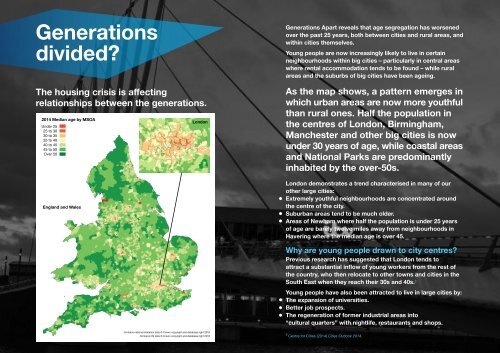Generations apart
Generations-Apart-Brochure
Generations-Apart-Brochure
Create successful ePaper yourself
Turn your PDF publications into a flip-book with our unique Google optimized e-Paper software.
<strong>Generations</strong><br />
divided?<br />
The housing crisis is affecting<br />
relationships between the generations.<br />
2014 Median age by MSOA<br />
Under 25<br />
25 to 30<br />
30 to 35<br />
35 to 40<br />
40 to 45<br />
45 to 50<br />
Over 50<br />
England and Wales<br />
London<br />
<strong>Generations</strong> Apart reveals that age segregation has worsened<br />
over the past 25 years, both between cities and rural areas, and<br />
within cities themselves.<br />
Young people are now increasingly likely to live in certain<br />
neighbourhoods within big cities – particularly in central areas<br />
where rental accommodation tends to be found – while rural<br />
areas and the suburbs of big cities have been ageing.<br />
As the map shows, a pattern emerges in<br />
which urban areas are now more youthful<br />
than rural ones. Half the population in<br />
the centres of London, Birmingham,<br />
Manchester and other big cities is now<br />
under 30 years of age, while coastal areas<br />
and National Parks are predominantly<br />
inhabited by the over-50s.<br />
London demonstrates a trend characterised in many of our<br />
other large cities:<br />
Extremely youthful neighbourhoods are concentrated around<br />
the centre of the city.<br />
Suburban areas tend to be much older.<br />
Areas of Newham where half the population is under 25 years<br />
of age are barely twelve miles away from neighbourhoods in<br />
Havering where the median age is over 45.<br />
Why are young people drawn to city centres?<br />
Previous research has suggested that London tends to<br />
attract a substantial inflow of young workers from the rest of<br />
the country, who then relocate to other towns and cities in the<br />
South East when they reach their 30s and 40s. 9<br />
Young people have also been attracted to live in large cities by:<br />
The expansion of universities.<br />
Better job prospects.<br />
The regeneration of former industrial areas into<br />
“cultural quarters” with nightlife, restaurants and shops.<br />
Contains national statistics data © Crown copyright and database right 2016<br />
Contains OS data © Crown copyright and database right 2016<br />
9<br />
Centre for Cities (2014) Cities Outlook 2014.


